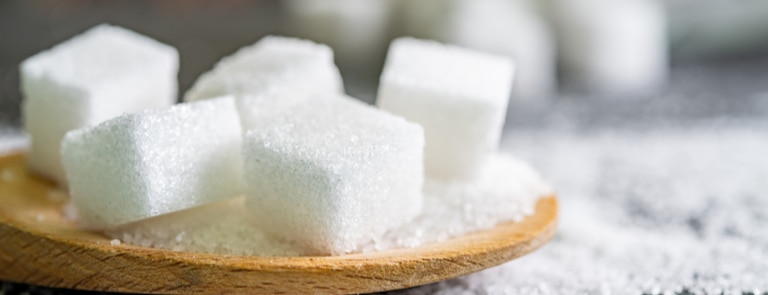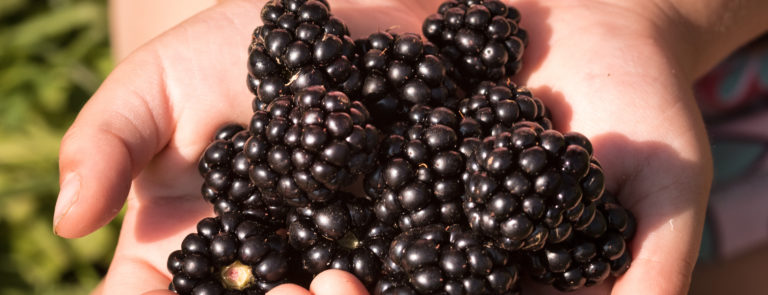15% off €25
How much sugar should you have a day?

Too much sugar is harmful, and you should get no more than 5% of your daily calories from added sugar sources.
But what does ‘added sugar’ mean, how many grams of sugar per day is recommended, how much sugar is too much and is it OK to eat natural sugar?
Relax, we have all the answers.
What is added sugar?
Added sugar – also called free sugar – refers to sugar that has been added to a food or beverage – either during the manufacturing process or by the consumer (you) at home.
Added sugar is added to food that may be sweet naturally, such as fruit juice, or food that doesn’t seem sweet at all, like gravy.
Added sugar doesn’t include the sugar found in fruit, vegetables (including sucrose and fructose) and dairy products (lactose). This type of sugar occurs naturally in many plant and animal foods and is a healthy part of the diet.
This is because natural sugar generally occurs in relatively small doses, and comes along with the benefits of vitamins, minerals, protein and fibre which slow the release of sugar into the bloodstream.1
Why do we need sugars?
Sugar is a carbohydrate, which the body and brain use as fuel.
Glucose – a product of carbohydrate digestion – is used as a primary fuel source and helps the central nervous system to run.2
Having said that, we don’t need to consume any added sugars at all. There is enough naturally occurring sugar in foods like fruits and vegetables to provide enough energy for the body.
Sugar itself contains no nutrients, which is why it’s often referred to as ‘empty calories’.
Food companies know that adding sugar to the things we eat is a tried-and-tested way to get us to develop a taste for them. Sugar enhances flavour and balances out saltiness. It also activates the reward systems in our brain, causing the release of ‘happy chemicals’ like dopamine.3
This is because we evolved to be motivated by and seek out energy-dense foods. Millions of years ago, our survival depended on this skill. Today, with the abundance of food available in the UK – not so much.
Added sugar finds its way into almost all processed foods and drinks, including savoury foods which you’d never guess contained sugar. As a result, most people end up eating far too much sugar.
Handpicked content: A guide to sugar
How many calories in a teaspoon of sugar?
Sugar weighs in at 4 calories (kcal) per gram.4
1 teaspoon holds 4g of sugar, making sugar 16kcal per teaspoon.
How many grams of sugar per day?
It might surprise you to learn that you shouldn’t be getting more than 5% of your daily calories from added sugar sources.
What is the daily recommended sugar intake?
The recommended daily intake of sugar for adults should not exceed 30g of added sugar a day.5
Children aged 7 – 10 shouldn’t exceed 24g sugar per day, and children aged 4 – 6 shouldn’t exceed 19g. Babies and toddlers should avoid added sugar completely.6
Remember, your daily sugar limit doesn’t count the naturally occurring sugars found in fruit, vegetables and dairy products.
However, it does include sugar from honey, agave, maple syrup, and sugar-sweetened drinks, which should all be counted in your daily amount of sugar.
Getting to know which foods and drinks are high in added sugar is the first step to helping you avoid them and stay within your 30g daily limit.
There are the more obvious sources such as cakes, biscuits, sweets, pastries and sweet-tasting fizzy drinks, which should be avoided as much as possible.
Further, there are countless places in the modern diet where added sugar hides.
Summary
- Added sugar – aka free sugar – is sugar that has been added to a food or beverage
- Our bodies use natural sugar for energy and brain function – but too much added sugar is harmful
- The NHS recommends we eat less than 30g added sugar each day
- Processed food today tends to be high in added sugar – even savoury food
Where is added sugar hiding?
Choosing seemingly ‘healthy’ foods is increasingly difficult in today’s food landscape. Many products are marketed as healthy when they actually contain untold amounts of sugar.
Remember, sugar also goes by many names. Some common aliases of added sugar include:7
- corn sugar
- dextrose
- fructose
- glucose
- high-fructose glucose syrup
- honey
- maple syrup
- agave syrup
- invert sugar
- isoglucose
- levulose
- maltose
- molasses
- sucrose
Get into the habit of looking at the list of ingredients on the food you eat.
Whole foods such as oats, nuts, fruit and grains should only have one ingredient. Processed foods and refined grains will come with a long ingredients list – and if you see sugar in the first three or four ingredients – think twice about adding it to your regular shopping basket.
Handpicked content: How to cut down on sugar as a family
Watch out for these foods which may be high in added sugar:
-
Cereal bars
You’re unlikely to view breakfast cereal bars as a treat, but they can contain as much sugar as a chocolate bar or biscuit.
Cereal bars can contain around 14g sugar per pack, just under half of your maximum grams of sugar per day.8
If sugar (or any of its variants – see above) is listed among the top few ingredients, save it for a treat.
-
Low-fat foods
Those of us who choose low-fat and ‘diet’ foods should be aware of the role sugar plays in these choices. Fat-free foods often have plenty of added sugar to replace the taste lost when the fat is removed, meaning they’re no longer a healthy choice.
In fact, you are probably better off selecting a full-fat version as this will promote a feeling of satiety (fullness) you won’t get from fat-free, high-sugar foods.
-
Sauces
Just one portion of tomato-based pasta sauce can have around 10g added sugar. This means you are a third of your way to your daily upper limit for added sugar without even factoring in everything else you’ve eaten that day.
Ready-made curry and Asian-inspired sauces can be high in added sugar. For example, stir-in sweet and sour sauce has 20.2g sugar per 100g.9 We recommend ditching the stir-ins and making your own – so much healthier and more delicious.
-
Condiments
Ketchup, BBQ sauce, salsa, relish, chilli sauce, mint sauce and mustard can all be surprisingly high in sugar. Manufacturers add sugar to make these things more palatable and appealing to us, as well as to balance out a high salt content or acidic flavour.
Often, condiments such as these contain a gram of sugar per teaspoon. Most people use a lot more than a teaspoon – so you can see how quickly it adds up.
-
Fruit drinks
Fruit juice should not be cut out as it contains vital vitamins and nutrients, but you should ensure that the juice has no added sugar. Further, you should keep your portions to strictly 150ml per day, as fruit juices are much higher in calories and natural sugars than whole fruits, as sugar is released as part of the juicing process.10
Sweetened fruit juice can contain around 9.8g sugar per 100ml. Flavoured water and squashes can also be high in sugar. Some squashes contain 24.6g per 100ml.11
-
Fizzy drinks
30g sugar is equivalent to around 7 teaspoons, which doesn’t go a long way in sugary treats. There is 35g sugar alone in a 330ml can of cola.12
If you drink this with a blueberry muffin at your desk at 3pm, you’ve consumed nearly 70g sugar, already more than doubling your daily sugar limit.
-
Salad dressing
Another source of sneaky added sugar, salad cream, Caesar dressing, ranch dressing and honey mustard dressing all contain more sugar than you’d expect.
Salad cream, for example, contains 16.7g per 100g.13
-
Breakfast cereals
Despite a reputation as the healthy option, breakfast cereals can be filled with added sugar. Choices like frosted flakes (which contain 37g sugar per 100g) are particularly bad for you.14
-
Alcohol
Many people don’t think to include sugars from alcohol in their daily quota – but this is a mistake.
According to Drinkaware, alcoholic drinks account for 11% of the UK population’s daily intake of added sugar.15 Fortified wines, sherries, liqueurs and cider are particularly sugary, but wine, prosecco, champagne and some beers are also high in sugar.
-
Low fat yoghurt
Feeling smug about choosing the low fat, healthy option? Not so fast. Diet yoghurts are usually high in added sugar to make up for the loss of taste when the fat is taken away.
Lactose from milk and sucrose from fruit in a yoghurt don’t count as ‘added’ or ‘free’ sugar.
Handpicked content: The best sugar-free chocolates and snacks
How much natural sugar a day is recommended?
There is no official recommendation on how much sugar per day from natural sources is OK. Health experts aren’t worried about people eating too much sugar through natural sources – and here’s why.
All sugar is processed by the body in the same way, whether it is an added/free sugar or sugar from a naturally occurring source. However, when you eat a food containing natural sugar (for example, a banana), you’re also consuming vitamins, minerals, fibre and other nutrients.
The presence of these additional nutrients (which you don’t get with a can of cola or cake for instance) mean that the natural sugars are absorbed more slowly into the bloodstream, keeping your blood sugar in balance.16 The fibre and additional nutrients also help fill you up sooner, preventing overeating of foods containing natural sugar.
How much sugar is there in fruit?
High sugar fruits:
- Grapes (16g sugar per 100g)
- Lychees (15g sugar per 100g)
- Passionfruit (11g sugar per 100g)
- Pomegranate (14g sugar per 100g)
- Mango (14g sugar per 100g)
- Cherries (13g sugar per 100g)
- Bananas (12g sugar per 100g)17
Medium sugar fruits:
- Oranges (9g sugar per 100g)
- Apples (10g sugar per 100g)
- Pears (10g sugar per 100g)
- Nectarines (8g sugar per 100g)
- Papaya (8g sugar per 100g)
- Peaches (8g sugar per 100g)
Low sugar fruits:
- Raspberries (4.4g sugar per 100g)
- Blackberries (4.9g sugar per 100g)
- Strawberries (4.9g sugar per 100g)
- Starfruit (4g sugar per 100g)18
Summary
- Always check the label for added sugar, which may be called a different name (sucrose, dextrose, maltose etc)
- Foods like sauces, condiments, low-fat foods, breakfast cereals and bars are high in sugar
- Drinks such as fruit juices, fizzy drinks and alcohol are high in sugar
- Despite containing sugar, the fibre and additional nutrients make natural sugars a healthy option
Read next: 8 easy ways to cut down on sugars & sweeteners
Last updated: 28 April 2021
- https://sitn.hms.harvard.edu/flash/2015/natural-and-added-sugars-two-sides-of-the-same-coin/
- https://www.sugar.org/health/the-basics/
- https://www.ncbi.nlm.nih.gov/pmc/articles/PMC2235907/
- https://www.nutrition.org.uk/nutritionscience/nutrients-food-and-ingredients/carbohydrate.html/
- https://www.nhs.uk/live-well/eat-well/how-does-sugar-in-our-diet-affect-our-health/
- https://www.nhs.uk/live-well/eat-well/how-does-sugar-in-our-diet-affect-our-health/
- https://www.nhs.uk/live-well/eat-well/top-sources-of-added-sugar/
- https://www.diabetes.org.uk/guide-to-diabetes/enjoy-food/eating-with-diabetes/diabetes-food-myths/cereal-bars
- https://www.nhs.uk/live-well/eat-well/top-sources-of-added-sugar/
- https://www.nhs.uk/live-well/eat-well/water-drinks-nutrition/
- https://www.nhs.uk/live-well/eat-well/top-sources-of-added-sugar/
- https://www.theguardian.com/news/datablog/2014/jun/12/how-much-sugar-is-in-your-fizzy-drink
- https://www.nhs.uk/live-well/eat-well/top-sources-of-added-sugar/
- https://www.diabetes.co.uk/blog/2015/03/sugar-in-cereal-who-are-the-worst-offenders/
- https://www.drinkaware.co.uk/facts/health-effects-of-alcohol/effects-on-the-body/alcohol-and-sugar
- https://sitn.hms.harvard.edu/flash/2015/natural-and-added-sugars-two-sides-of-the-same-coin/
- https://www.myfooddata.com/articles/high-sugar-fruits.php
- https://www.myfooddata.com/articles/low-sugar-fruits.php



